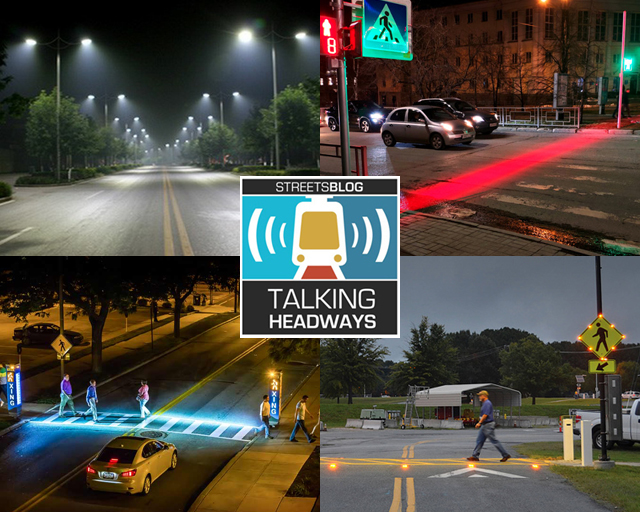In their new book, "Outdoor Lighting for Pedestrians," Frank Markowitz and Leni Schwendinger talk about creating legible nighttime spaces, programming those spaces, and the future of lighting and transportation.
For those of you who get your news through your eyes and not your ears, there’s an edited transcript below the audio player. For an unedited transcript, click here.
Jeff Wood; It’s so interesting you talk about the nature of light, and how it’s there and you see it obviously and it exists. But it’s not a solid. It’s not something you can touch necessarily. It can create places, it can create a place. It can make it feel like you’re enveloped or you’re able to go to a certain place or not able to go to another place because of whether it’s dark or light or otherwise. And so I think it’s interesting from that perspective. Thinking about it in the abstract of, "it’s not a solid object but it does create place."
Frank Markowitz; And there are a lot of different aspects of light that affect how it changes the environment — and it’s not just the sheer amount of light, illuminance or luminance levels, but factors like glare or color rendition and how accurately colors show up. Those are also important factors: how the lighting is used. We know France made a major effort to add lighting to create a very attractive nighttime environment and point to areas of historic interest or visual interest and to tailor the lighting to the particular characteristics of the sights that are being lit.
And I mention in the book urban park lighting where they’ll try to vary the lighting characteristics which is color, appearance, color temperature of lighting depending on whether it’s shining on a historic feature, park, or more the vegetation. So there’s a lot to consider to determine how effective lighting is.
Wood: Well I just had no idea there were so many ways to measure light. Until I read the book there’s just so many ways to measure and understanding the importance of things like contrast. For folks that are listening what is contrast and why is it so important to transportation planning and lighting generally?
Markowitz: So that’s a good point, Jeff. There’s are a number of different metrics and factors. Contrast is how well the object of interest like a pedestrian is showing up against the background, and positive contrast is when the pedestrian appears brighter than the background, negative when the background is brighter than the pedestrian. All those different factors and metrics can be really important. I mentioned how San Francisco I would deal with pedestrian-safety issues, hotspots. There’s one intersection I remember dealing with a high level of nighttime pedestrian injuries and fatalities: Market and Castro intersection, which is Harvey Milk Plaza and also a location where there are a lot of pedestrian activity, the gay-rights center of San Francisco.
In any case, I consulted a roadway lighting engineer and expressed concern about the lighting at that location and, to my non-expert eye, it seemed like there was a problem. Just my picking out peds crossing the street and this engineer went out and measure light levels presumably illuminance or the amount of light falling on crosswalks and pedestrians. He came back and said, “it’s fine, it meets light standards.” But that can be missing a lot of other factors. Contrast can be one: Perhaps pedestrians have a light but there’s also so much light in the background that they are washed out. There can be glare; the drivers are getting a lot of unwanted light in their eyes. Often there’s a problem that a crosswalk is pretty brightly lit, but the streetcorner is so underlit that pedestrians seem to “pop” into view and you don’t get any real warning. You don’t know at nighttime that it’s a pedestrian crossing until they are in the crosswalk. So there are a lot of other factors to consider
Leni Schwendinger: I just want to put a plug in for lighting designers. I do have a little anecdote where I say, "give two people the standards and one is the engineer and the other is a designer and they may come up with two completely different solutions that match the standards." Competency is one thing. But the psychological responses, the nuances, as your calling it, measurements: uniformity, lack of uniformity, texture. Including brightness, right? But not just brightness. All have to do with a good lighting design.
I think the book is going to be super helpful so that engineers get a sense of the nuances and get a sense of the complexity so that they do begin to request a lighting designer on the job. Let’s collaborate with a lighting designer for the basis of design to get those nuances on the page and some early specifications so that is a set level of threshold basis of design. I’ve worked on major engineering projects, subways, bridges, things like that and, really honestly, a lighting designer is going to come up generally with a different solution unless they’ve had design experience.





